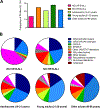Has Ph-like ALL Superseded Ph+ ALL as the Least Favorable Subtype?
- PMID: 34865703
- PMCID: PMC8649641
- DOI: 10.1016/j.beha.2021.101331
Has Ph-like ALL Superseded Ph+ ALL as the Least Favorable Subtype?
Abstract
Philadelphia chromosome-like acute lymphoblastic leukemia (Ph-like ALL) is a subset of high-risk B-ALL associated with high relapse risk and inferior clinical outcomes across the pediatric-to-adult age spectrum. Ph-like ALL is characterized by frequent IKZF1 alterations and a kinase-activated gene expression profile similar to that of Philadelphia chromosome-positive (Ph+) ALL, yet lacks the canonical BCR-ABL1 rearrangement. Advances in high-throughput sequencing technologies during the past decade have unraveled the genomic landscape of Ph-like ALL, revealing a diverse array of kinase-activating translocations and mutations that may be amenable to targeted therapies that have set a remarkable precision medicine paradigm for patients with Ph + ALL. Collaborative scientific efforts to identify and characterise Ph-like ALL during the past decade has directly informed current precision medicine trials investigating the therapeutic potential of tyrosine kinase inhibitor-based therapies for children, adolescents, and adults with Ph-like ALL, although the most optimal treatment paradigm for this high-risk group of patients has yet to be established. Herein, we describe the epidemiology, clinical features, and biology of Ph-like ALL, highlight challenges in implementing pragmatic and cost-effective diagnostic algorithms in the clinic, and describe the milieu of treatment strategies under active investigation that strive to decrease relapse risk and improve long-term survival for patients with Ph-like ALL as has been successfully achieved for those with Ph + ALL.
Keywords: ABL; Acute lymphoblastic leukemia; CRLF2; Clinical trials; JAK/STAT; Philadelphia chromosome-like; Precision medicine; Tyrosine kinase inhibitor.
Copyright © 2021. Published by Elsevier Ltd.
Conflict of interest statement
Disclosures: Thai Hoa Tran: No real or apparent conflicts of interest
Figures


Similar articles
-
Philadelphia Chromosome-like Acute Lymphoblastic Leukemia.Clin Lymphoma Myeloma Leuk. 2017 Aug;17(8):464-470. doi: 10.1016/j.clml.2017.03.299. Clin Lymphoma Myeloma Leuk. 2017. PMID: 28842136 Free PMC article. Review.
-
Why and how to treat Ph-like ALL?Best Pract Res Clin Haematol. 2018 Dec;31(4):351-356. doi: 10.1016/j.beha.2018.09.003. Epub 2018 Sep 20. Best Pract Res Clin Haematol. 2018. PMID: 30466746 Review.
-
Philadelphia-like acute lymphoblastic leukemia: the journey from molecular background to the role of bone marrow transplant-review article.Ann Hematol. 2023 Jun;102(6):1287-1300. doi: 10.1007/s00277-023-05241-2. Epub 2023 May 2. Ann Hematol. 2023. PMID: 37129698 Free PMC article. Review.
-
Philadelphia chromosome-like acute lymphoblastic leukemia.Blood. 2017 Nov 9;130(19):2064-2072. doi: 10.1182/blood-2017-06-743252. Epub 2017 Oct 2. Blood. 2017. PMID: 28972016 Free PMC article. Review.
-
The biology of Philadelphia chromosome-like ALL.Best Pract Res Clin Haematol. 2017 Sep;30(3):212-221. doi: 10.1016/j.beha.2017.07.003. Epub 2017 Jul 6. Best Pract Res Clin Haematol. 2017. PMID: 29050694 Review.
Cited by
-
Single-cell heterogeneity and dynamic evolution of Ph-like acute lymphoblastic leukemia patient with novel TPR-PDGFRB fusion gene.Exp Hematol Oncol. 2023 Feb 17;12(1):19. doi: 10.1186/s40164-023-00380-8. Exp Hematol Oncol. 2023. PMID: 36797781 Free PMC article.
-
New scaffolds for type II JAK2 inhibitors overcome the acquired G993A resistance mutation.Cell Chem Biol. 2023 Jun 15;30(6):618-631.e12. doi: 10.1016/j.chembiol.2023.05.007. Epub 2023 Jun 7. Cell Chem Biol. 2023. PMID: 37290440 Free PMC article.
-
Clinical screening for Ph-like ALL and the developing role of TKIs.Hematology Am Soc Hematol Educ Program. 2022 Dec 9;2022(1):594-602. doi: 10.1182/hematology.2022000357. Hematology Am Soc Hematol Educ Program. 2022. PMID: 36485164 Free PMC article.
-
The Landscape of Secondary Genetic Rearrangements in Pediatric Patients with B-Cell Acute Lymphoblastic Leukemia with t(12;21).Cells. 2023 Jan 18;12(3):357. doi: 10.3390/cells12030357. Cells. 2023. PMID: 36766699 Free PMC article. Review.
References
Publication types
MeSH terms
Substances
Grants and funding
LinkOut - more resources
Full Text Sources
Miscellaneous

